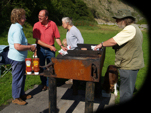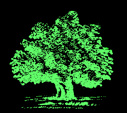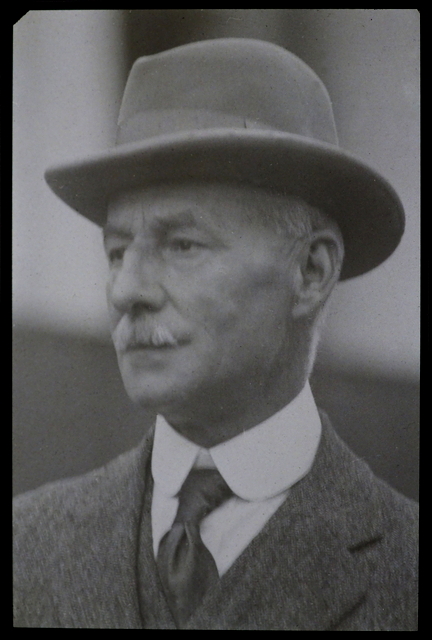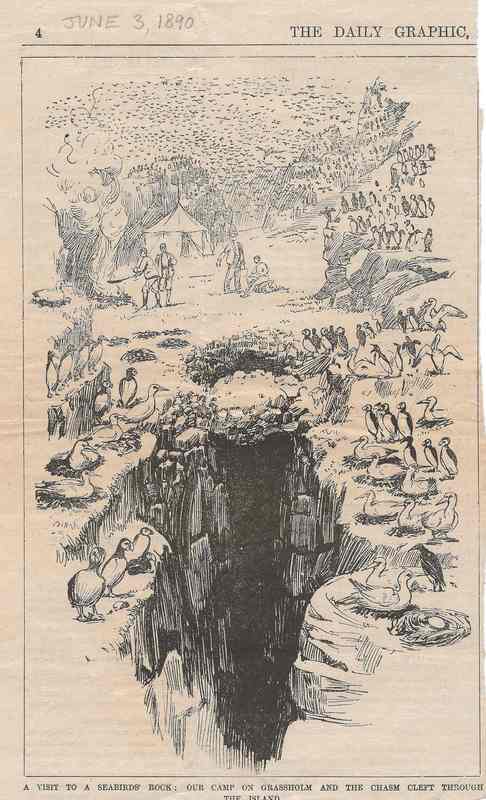
Cardiff
Naturalists' Society
Cymdeithas Naturiaethwyr
Caerdydd

Thomas William Proger, F.Z.S., 1860-1947 31st and 55th President
|
Back to the 150th Anniversary index We have an obituary in volume LXXIX of the transactions 1948 T W Proger photographed on 3rd October 1921 from the society archives
As is noted above he had a business interest in the Falkland islands, and in 1919 he visited the Islands and colleted at least a trilobite which is documented in the The Falkland Islands Journal Vol 10 (2): 25-29, he may have made other visits but in 1920 and 1922 he donated collections of fossils he had collected Fossils From The Falkland Islands In The Collection Of The National Museum Of Wales, Cardiff. by Phil Stone, Tom Sharpe and Robert Owens In the Biology Curators' Group B.C.G. Newsletter, Volume 2 Number 8. October 1980 there is a Features Institution on the Department of Zoology National Museum of Wales describing the major collections in that there is a short description of an insect collection he donated "Thomas William Proger, F.Z.S. (1860-1947) A small collection of about 1,000 insects from Costa Rica where his eldest son worked a coffee estate. Proger was associated with the National Museum of Wales from its inception and was a keen naturalist who lived in Cardiff but travelled extensively in South America." Strangely his obituary does not mention a key event for the Society which has already been mentioned under two other former presidents in that In 1890 he visited Grassholm with three other members of the Cardiff Naturalists' Society, Joshua John (JJ)Neale, Thomas H Thomas and Henry West, to see the gannets. Here they witnessed the destruction of the sea birds by a naval company from HMS Sir Richard Fletcher. They were appalled by the destruction and Thomas sketched the scenes which later appeared in the Daily Graphic and Animal World. Questions were asked in Parliament and eventually the sailors were prosecuted by the RSPCA and fined. In order to aid the protection of the birds on the Welsh off-shore islands as well as to aid research, J.J. Neale took over the lease of Grassholm and Skomer. T H Thomas drawing of the camp on Grassholm 
T H Thomas in front of case of shot birds A fuller writeup with more pictures and information is given on this page The Sad Tale of the Grassholm Gannetry As has been noted above he was president twice and the second occasion was the Societies Diamond Jubilee in 1927. This was a grand affair with a programme of events which took place across the 2nd, 3rd, and 4th of November 1927 and included a broadcast from the BBC (something we managed to repeat in a much less glamorous way in 2017 as can be heard HERE) Invitation to the Jubilee Jubilee Programme Charabanc departure from the Museum (in the background) possibly at the jubilee Back to the 150th Anniversary index Before this... Donald Rose Paterson M.D., F.R.C.P., F.S.A. (1862-1939) 30th and 52nd President Next up... Philip Rhys Griffiths, M.B., B.S. (1857-1920) 32nd President And for his second Presidency Before this... Robert William Atkinson, B.Sc. (Lond.), F.I.C., F.C.S. 22nd and 54th President Next up... Frederick John North O.B.E., D.Sc, F.G.S., F.M.A. (1889-1968) 56th President See our Full list of Presidents These pages are part of the Cardiff Naturalists' Society 150th Anniversary celebrations and are about our history and are celebrating the people who developed our Society and helped build the city and the cultural heritage of Cardiff. You can read more about that using the links above If you want to read about the ways we study the wildlife and environment of the Cardiff area and its surroundings, and about the talks we have about the wildlife of the world, and find the programme of talks, walks and other events that we do then please take a look at our main website, our blog and our facebook and twitter feeds for up to date news |




